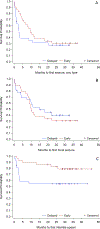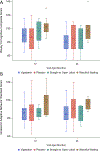Early Treatment with Vigabatrin Does Not Decrease Focal Seizures or Improve Cognition in Tuberous Sclerosis Complex: The PREVeNT Trial
- PMID: 37638552
- PMCID: PMC10899525
- DOI: 10.1002/ana.26778
Early Treatment with Vigabatrin Does Not Decrease Focal Seizures or Improve Cognition in Tuberous Sclerosis Complex: The PREVeNT Trial
Abstract
Objective: This study was undertaken to test the hypothesis that early vigabatrin treatment in tuberous sclerosis complex (TSC) infants improves neurocognitive outcome at 24 months of age.
Methods: A phase IIb multicenter randomized double-blind placebo-controlled trial was conducted of vigabatrin at first epileptiform electroencephalogram (EEG) versus vigabatrin at seizure onset in infants with TSC. Primary outcome was Bayley Scales of Infant and Toddler Development, Third Edition (Bayley-III) cognitive assessment score at 24 months. Secondary outcomes were prevalence of drug-resistant epilepsy, additional developmental outcomes, and safety of vigabatrin.
Results: Of 84 infants enrolled, 12 were screen failures, 4 went straight to open label vigabatrin, and 12 were not randomized (normal EEG throughout). Fifty-six were randomized to early vigabatrin (n = 29) or placebo (n = 27). Nineteen of 27 in the placebo arm transitioned to open label vigabatrin, with a median delay of 44 days after randomization. Bayley-III cognitive composite scores at 24 months were similar for participants randomized to vigabatrin or placebo. Additionally, no significant differences were found between groups in overall epilepsy incidence and drug-resistant epilepsy at 24 months, time to first seizure after randomization, and secondary developmental outcomes. Incidence of infantile spasms was lower and time to spasms after randomization was later in the vigabatrin group. Adverse events were similar across groups.
Interpretation: Preventative treatment with vigabatrin based on EEG epileptiform activity prior to seizure onset does not improve neurocognitive outcome at 24 months in TSC children, nor does it delay onset or lower the incidence of focal seizures and drug-resistant epilepsy at 24 months. Preventative vigabatrin was associated with later time to onset and lower incidence of infantile spasms. ANN NEUROL 2023.
© 2023 The Authors. Annals of Neurology published by Wiley Periodicals LLC on behalf of American Neurological Association.
Conflict of interest statement
POTENTIAL CONFLICTS OF INTEREST
Nothing to report
Figures




Comment in
-
Vigabatrin in Epilepsy Related to TSC: Does it PREVeNT AND OR (EPI) STOP Seizures OR… Do We Need Some More STEPS as VI RAP?Epilepsy Curr. 2024 Jan 10;24(2):87-89. doi: 10.1177/15357597231225097. eCollection 2024 Mar-Apr. Epilepsy Curr. 2024. PMID: 39280055 Free PMC article. No abstract available.
References
-
- Northrup H, Aronow ME, Bebin EM, et al. International Tuberous Sclerosis Complex Consensus Group. Updated international tuberous sclerosis complex diagnostic criteria and surveillance and management recommendations. Pediatr Neurol 2021;123:50–66 - PubMed
-
- Kwiatkowski DJ, Manning BD. Tuberous sclerosis: a GAP at the crossroads of multiple signaling pathways. Hum Mol Genet 2005;14:R251–R258 - PubMed

